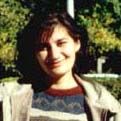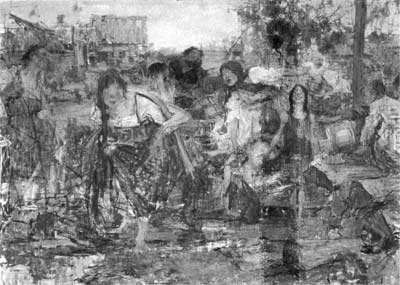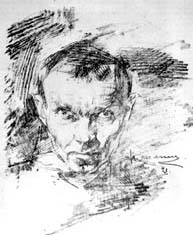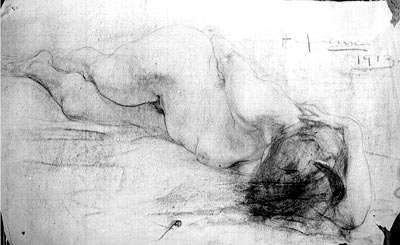Essays:The Creativity of Nicolai Fechin
From Content
| Revision as of 08:50, 10 April 2006 Andrey (Talk | contribs) ← Previous diff |
Current revision Andrey (Talk | contribs) |
||
| Line 1: | Line 1: | ||
| - | by Jonathan Farrell | + | by Galina Toulouzakova |
| {| border=0 style="border-top: 1px solid black; border-bottom: 1px solid black;" | {| border=0 style="border-top: 1px solid black; border-bottom: 1px solid black;" | ||
| | valign=top | | | valign=top | | ||
| - | [[image:Seeking the Timeless- About Georgianna Krieger.Jonathan Farrell.jpg]] | + | [[image:The Creativity of Nicolai Fechin.Galina Toulouzakova.jpg]] |
| | <div style="margin-left: 1em"><font class=annotation> | | <div style="margin-left: 1em"><font class=annotation> | ||
| - | Native to California, '''Jonathan Farrell''' describes himself as a writer and an aspiring artist. With a Bachelor of Arts degree in Philosophy, he followed the path of the social services field. While working in social work he decided to follow his heart's desire and began writing. | + | '''Galina Toulouzakova''' holds degrees in art history and economics from the Saint Petersburg Institute of Art. She works for the Museum of Fine Art in Kazan, Russia and is Lecturer in Philosophy at Kazan Pedagogical University. Her thesis was devoted to the art of Nicolai Fechin. |
| - | + | ||
| - | Once he accepted this new path then the journey toward art began. No sooner did he leave his job in social work when an opportunity to write for a neighborhood newspaper appear. While taking various part-time jobs, For almost ten years, Jonathan has been writing for various neighborhood publications among them are the ''Sunset Beacon & Richmond Review.'' And during that time he has pursued other creative interests such as: journalism, acting, collage, photography and cooking. | + | |
| - | + | ||
| - | Finding the city of San Francisco to be "a place where the world is," Jonathan is continually inspired by the city's life and vitality. He hopes to be a truly cosmopolitan individual as he says, ''"To be a citizen of the world is a wonderful privilege and no better place to learn and grow in that sense of citizenship than in San Francisco."'' | + | |
| </font></div> | </font></div> | ||
| |} | |} | ||
| - | That which is universal and timeless is what artist Georgianna Krieger strives to accomplish in her sculpture. | + | [[image:The Creativity of Nicolai Fechin.1.jpg]] |
| - | Inspired by the ancients such as the Greeks, Krieger is not shy to say what's missing in the 21st Century, "it's anything but timeless, it's all about time and speed," she said. | + | The Russian-American artist, painter, draughtsman and foreman of applied arts, Nicolai Fechin, was born in Kazan in 1881 and died in Los Angeles in 1955. He represents one of the important links in the development of Russian and European fine arts at the beginning of the 20th century, leaving an indelible mark on the American art of the 1930's. Fechin's art can be described as an aspiration to universality where parities exist between tradition and innovation, between technology and craft, under the rubric of the problems of time and originality. In spite of these archetypal issues and their relation to the history of art, Fechin has remained relatively obscure due, in part, to his birthplace in Kazan and his training at the St. Petersburg Academy of Fine Art where the themes of early 20th Russian art made a deep and everlasting impression on him and his art. |
| - | The opportunity to visit her studio that sits behind a charming Edwardian style cottage in San Francisco's Richmond District was a rare glimpse into the life of an artist at work. | + | Although Fechin is considered to be one of the outstanding portraitists of the 20th century, he mastered many styles and techniques including: genre composition (i.e. landscape painting, nudes, still lives), printed graphics (i.e. gouaches, nature drawings), studies in nudity, decorative and applied arts (i.e. woodcarving, metal and ceramic sculpture) and theatrical scenery and architectural design. Fechin's unique art system developed through the syncretism of numerous early 20th art techniques and movements. Principal among these techniques and movements was '''''Peredvishniki,''''' which blended elements of Impressions and Expressionism with Realism. Yet, it is still Modern Art that influenced him and what is most apparent when his art is seen in fine and retrospectively. |
| - | Krieger's home life is shared with her husband Michael and their baby boy Philo. Together they support each other in their new responsibility as parents. While Michael, a composer of music watches little Philo, Krieger is able to step through the wildflowers in the backyard to a shed she has converted into an extension of her studio. | + | Fechin's creativity is wholly connected to the problems of Russian art at the beginning of the 20th century. In spite of the fact that he spent half his life in the United States, he remained a Russian artist even while creating art relating to the Indians themes of the Taos Art Colony and, along with his landscapes and portraits has a rightful place in the repertoire of American art. |
| - | Apart from a few innovations/conveniences such as, silicon rubber moulds Krieger says, "I use traditional methods. I sculpt the same way the ancients did." The process of it is the same. | + | [[image:The Creativity of Nicolai Fechin.2.jpg]] |
| - | + | [[image:The Creativity of Nicolai Fechin.3.jpg]] | |
| - | (At the beginning of a) work with a small scale that is 1/6 to 1/3 of life scale (size) "I think of most of my sculptures as studies for a life-size or monumental scale work," Krieger said. | + | |
| - | + | ||
| - | There are dozens of works in process, all in various stages. Krieger explains, "When I studied sculpture, I chose the traditional figure as my path (of study) because I feel the human figures speaks to all people of any culture or time period." | + | |
| - | + | ||
| - | She continued, "I took time to study anatomy and the Greek system of (poise and) proportions." This is found in the archaic examples left to us by the Greeks, known as the "Kouros" figures. | + | |
| - | + | ||
| - | Emerging around the year 600, BC [http://en.wikipedia.org/wiki/Kouros the Kouros] is the ideal form of human beauty and strength. This ideal form was usually expressed through a youthful male figure. Some scholars hypothesize that the "youthful athlete" represented neither gods nor men but something in between - the hero. | + | |
| - | + | ||
| - | [http://www.getty.edu/art/gettyguide/artObjectDetails?artobj=12908 Scholars] also believe that this style was the prototype for the further development of Greek sculpture, and was most likely borrowed from the Egyptians. The similarities in various samples between Greek and Egyptian works are striking. | + | |
| - | + | ||
| - | [[image:Seeking the Timeless- About Georgianna Krieger.1.1.jpg]] | + | |
| - | [[image:Seeking the Timeless- About Georgianna Krieger.1.2.jpg]] | + | |
| - | + | ||
| - | Yet the use and philosophies behind the sculpture of the two cultures are different. For Egypt as example, the sculptures were used for definite religious beliefs (surrounding the 'ka' or personality of soul of the deceased). This type of 'mystical' element in their sculpted helped with the idea of an afterlife. | + | |
| - | + | ||
| - | Allusions to a realm of the 'metaphysical' might be obvious, but for the Greeks such notions of an afterlife were obscure and not afforded to everyone. The Kouros as naked male hero was a model for perfection. This was a tribute to beauty and strength. Unfortunately the esteem for this concept of perfection was not fully extended to females. | + | |
| - | + | ||
| - | Taken directly from the stance of the 'kouros' Krieger adapts the ideal just the same, as she points to her sculpture entitled, "Strength." "I think my work has some of the classical qualities but it is very much of this era. Being that "the reference is intended to say something about the world today." | + | |
| - | + | ||
| - | [[image:Seeking the Timeless- About Georgianna Krieger.2.1.jpg]] | + | |
| - | [[image:Seeking the Timeless- About Georgianna Krieger.2.2.jpg]] | + | |
| - | + | ||
| - | Krieger's figures are naked as in the classical sense, but in the case of this piece (Strength) she says, "I tried to say something about the strength needed by women every day in the contemporary world." | + | |
| - | + | ||
| - | Bringing that classical ideal of strength and beauty into the present day world, Krieger clothed the figure of woman for this piece "in jeans and t-shirt." Krieger upholds the idea that there is a "fourth dimension" which is the 'metaphysical.' | + | |
| - | + | ||
| - | As she said, "Because we are ever moving, motion is inherent in the nature of our experiences. The human experience is shaped not only by our physicality but also by our intellectual capacity for memory and abstract thought." (This is what makes such pieces metaphysical). | + | |
| - | + | ||
| - | It was through Krieger's work with clay animation that as she said, "gave me an opportunity to do motion studies through time lapse photography. This is how I got to thinking about the fourth dimension." Not to say that all her pieces have to do with motion for as she noted, "some are still figures." "Those are about experiences when the world goes whipping past you as you think, feel or do something," Krieger said. | + | |
| - | + | ||
| - | "I am thinking about geometry and formal composition when I approach a figure." Yet she clarified, "my figures (sculpted) take a form from life but they are not so realistic as they are idealistic," Krieger said. | + | |
| - | + | ||
| - | After her formal study in art school Krieger spend several years working in commercial art fields making designs. As she explained, "I wondered how my art would fit into the modern world." | + | |
| - | + | ||
| - | Not abandoning her admiration of traditional sculpture as she worked in commercial art, Krieger perceived/understood something significant. | + | |
| - | + | ||
| - | Doing design work and making art can be related but are distinctly different from each other. Krieger explained, "I keep the two separate. I think most people don't understand that the skills involved in vigorous art making are transferable to other endeavors like designing and inventing." | + | |
| - | + | ||
| - | This is why she seldom speaks of her artwork to the circle of acquaintances she knows in her design work. And consequently, "I seldom talk about my design work when talking about sculpture." | + | |
| - | + | ||
| - | Yet it seems Krieger is most enthralled by sculpture. When she spoke about her experiences with sculpture her expressions and conversation glowed with an enthusiasm. (As if the Muses were at her side.) | + | |
| - | + | ||
| - | Drawn to sculpture from the beginning, her teacher at the University of the Arts in Philadelphia, Walter Erlebacher was "very inspirational," said Krieger. | + | |
| - | + | ||
| - | It was his teaching that set the path of sculpture at Krieger's feet. Along with studying the ancients, she admired the great ones like Michelangelo and Bernini. Krieger found Manuel Neri's work inspiring because of "his use of color on figurative sculpture." | + | |
| - | + | ||
| - | She too uses color in her sculpture "not so much for realism but (that) it has to do with the emotions and the content of the piece," she said. And as Krieger noted, "the Greeks painted their sculptures." | + | |
| - | + | ||
| - | She took a trip to Italy and the time she spent to observe the old world craftsmen was amazing as they "worked with the marble like it was butter." | + | |
| - | + | ||
| - | Krieger understands that art is something to share and she praised the support of the artistic community through venues such as the Sunset Artists Society founded in 1999. The weekend of May 31 to June 1, 2003, the Sunset Artists Society is sponsoring a local event at the Hall of Flowers (at 9th Ave. & Lincoln Way) in Golden Gate Park. Krieger will have her work on display. | + | |
| - | + | ||
| - | Krieger is also eagerly preparing for the annual "Open Studios" exhibit/neighborhood art shows sponsored by ArtSpan. A unique San Francisco institution that began literally in an artist's home not too many years ago, the event is a series of mini art shows featured at the home of participating artists over a period of consecutive weekends during the fall season. Krieger said, "This year my neighborhood (The Richmond District) will be the first on the list - weekend #1." | + | |
| - | + | ||
| - | (Incidentally for those of you who don't know San Francisco very well, Fall is when San Francisco has it's summer - Sept. thru early Nov.) | + | |
| - | + | ||
| - | (Incidentally for those of you who don't know San Francisco very well, Fall is when San Francisco weather is at it's best! September thru early November is the city's real summer). | + | |
| - | + | ||
| - | For Krieger's future endeavors she simply says, "I would be honored to have the opportunity to do large pieces for public spaces." | + | |
| - | + | ||
| - | Georgianna Krieger will also be teaching workshops on Figure Drawing and Introduction to Mould Making at Fogbelt Studio in SF's Sunset District. For more information about it visit [http://www.fogbeltstudio.com http://www.fogbeltstudio.com]. And for more information about Krieger and her work visit [http://www.shesculpts.com www.shesculpts.com]. | + | |
| - | + | ||
| - | + | ||
| - | {| border=0 | + | |
| - | | valign=top | | + | |
| - | {| align=left border=0 style="margin-top: .9em; margin-right: 1em" | + | |
| - | | [[image:Seeking the Timeless- About Georgianna Krieger.Georgianna Krieger.jpg]] | + | |
| - | |} | + | |
| - | <font class=annotation> | + | |
| - | '''Georgianna Krieger,'''<br> | + | |
| - | sculptor | + | |
| - | + | ||
| - | San Francisco sculptor Georgianna Krieger received her BFA in sculpture from the University of the Arts in Philadelphia where she studied with Harvey Citron and Walter Erlebacher and was the 1990 recipient of The Philadelphia Plastic Arts Society Award. Her life in the arts began at home with her mother, artist Anna Krieger and continued at the Arts Magnet High School in Dallas, Texas where she studied art and music. | + | |
| - | + | ||
| - | Over the years Ms. Krieger has worn many creative hats including commercial artist and designer, while continuing to work privately on her sculpture. Her work has included clay animation, murals, museum exhibit design, toy design as well as fine art. Believing that art is achieved through years of contemplative study and practice, she has worked to create a meaningful body of work. | + | |
| - | + | ||
| - | In late 2001 she premiered to the public a series of limited edition sculptures entitled ''Time And Space.'' Her figurative yet contemporary sculptures in bronze and other cast materials, are accompanied by a series of gesture drawings. | + | |
| - | + | ||
| - | Ms. Krieger lives in San Francisco's Richmond District with her husband, composer Michael Kaulkin and son Philo. She is available for commissions and her studio is open to the public in October as part of San Francisco's Open Studios. View some of her work at: [http://www.shesculpts.com www.shesculpts.com]. | + | |
| - | </font> | + | |
| - | |} | + | |
Current revision
by Galina Toulouzakova
| Galina Toulouzakova holds degrees in art history and economics from the Saint Petersburg Institute of Art. She works for the Museum of Fine Art in Kazan, Russia and is Lecturer in Philosophy at Kazan Pedagogical University. Her thesis was devoted to the art of Nicolai Fechin. |
The Russian-American artist, painter, draughtsman and foreman of applied arts, Nicolai Fechin, was born in Kazan in 1881 and died in Los Angeles in 1955. He represents one of the important links in the development of Russian and European fine arts at the beginning of the 20th century, leaving an indelible mark on the American art of the 1930's. Fechin's art can be described as an aspiration to universality where parities exist between tradition and innovation, between technology and craft, under the rubric of the problems of time and originality. In spite of these archetypal issues and their relation to the history of art, Fechin has remained relatively obscure due, in part, to his birthplace in Kazan and his training at the St. Petersburg Academy of Fine Art where the themes of early 20th Russian art made a deep and everlasting impression on him and his art.
Although Fechin is considered to be one of the outstanding portraitists of the 20th century, he mastered many styles and techniques including: genre composition (i.e. landscape painting, nudes, still lives), printed graphics (i.e. gouaches, nature drawings), studies in nudity, decorative and applied arts (i.e. woodcarving, metal and ceramic sculpture) and theatrical scenery and architectural design. Fechin's unique art system developed through the syncretism of numerous early 20th art techniques and movements. Principal among these techniques and movements was Peredvishniki, which blended elements of Impressions and Expressionism with Realism. Yet, it is still Modern Art that influenced him and what is most apparent when his art is seen in fine and retrospectively.
Fechin's creativity is wholly connected to the problems of Russian art at the beginning of the 20th century. In spite of the fact that he spent half his life in the United States, he remained a Russian artist even while creating art relating to the Indians themes of the Taos Art Colony and, along with his landscapes and portraits has a rightful place in the repertoire of American art.




